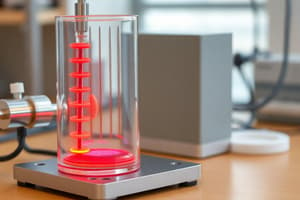Podcast
Questions and Answers
What is calorimetry primarily concerned with measuring?
What is calorimetry primarily concerned with measuring?
- The amount of heat involved in chemical processes only
- The amount of heat involved in both chemical and physical processes (correct)
- The amount of heat involved in physical processes only
- The specific heat of various substances
What is the role of a calorimeter in heat measurement?
What is the role of a calorimeter in heat measurement?
- To directly measure the amount of heat produced
- To serve as a heat source for reactions
- To change the temperature of the substance rapidly
- To prevent any heat exchange with its surroundings (correct)
What does the specific heat of a substance represent?
What does the specific heat of a substance represent?
- The energy released when a substance is melted
- The amount of heat required to raise the temperature of 1 g by 1°C (correct)
- The temperature change of a substance during a chemical reaction
- The total energy contained within the substance
Which equation correctly represents the relationship for calculating heat energy change?
Which equation correctly represents the relationship for calculating heat energy change?
How is the specific heat of water characterized in terms of heat energy?
How is the specific heat of water characterized in terms of heat energy?
What principle does calorimetry fundamentally rely on?
What principle does calorimetry fundamentally rely on?
When measuring heat absorption with water, what is typically done?
When measuring heat absorption with water, what is typically done?
What happens to the heat in a system according to the law of conservation of energy?
What happens to the heat in a system according to the law of conservation of energy?
What is the purpose of recording the temperature of the cold water every minute during the first 5 minutes?
What is the purpose of recording the temperature of the cold water every minute during the first 5 minutes?
Why must the test tube be submerged below the surface of the boiling water?
Why must the test tube be submerged below the surface of the boiling water?
What is the significance of recording the temperature of the calorimeter immediately after adding the hot metal?
What is the significance of recording the temperature of the calorimeter immediately after adding the hot metal?
What is the maximum duration for heating the metal sample in the water bath?
What is the maximum duration for heating the metal sample in the water bath?
What should be done immediately after the test tube is removed from boiling water?
What should be done immediately after the test tube is removed from boiling water?
How often should the temperature be recorded after the metal is added to the calorimeter?
How often should the temperature be recorded after the metal is added to the calorimeter?
What is the main purpose of the insulated walls in a calorimeter?
What is the main purpose of the insulated walls in a calorimeter?
What should be done to ensure full heat exchange within the calorimeter?
What should be done to ensure full heat exchange within the calorimeter?
What is the correct procedure if water splashes into the test tube containing the hot metal?
What is the correct procedure if water splashes into the test tube containing the hot metal?
Why is a thermometer included in the construction of a calorimeter?
Why is a thermometer included in the construction of a calorimeter?
What unit of measurement for specific heat is used in this experiment?
What unit of measurement for specific heat is used in this experiment?
If one were to build benches that are exposed to sunlight, which material would be preferable and why?
If one were to build benches that are exposed to sunlight, which material would be preferable and why?
Which of the following describes how heat is gained and lost in the calorimetry experiment?
Which of the following describes how heat is gained and lost in the calorimetry experiment?
What happens to the temperature of the equilibrated system during the experiment?
What happens to the temperature of the equilibrated system during the experiment?
What is the relationship between ΔT of the cold water and the heat gained?
What is the relationship between ΔT of the cold water and the heat gained?
What is the purpose of measuring the maximum temperature during the experiment?
What is the purpose of measuring the maximum temperature during the experiment?
How is the change in temperature (ΔT) of the cold water calculated?
How is the change in temperature (ΔT) of the cold water calculated?
Which measurement signifies the heat lost by the warm water in the experiment?
Which measurement signifies the heat lost by the warm water in the experiment?
What is needed to determine the specific heat and atomic mass of the metal?
What is needed to determine the specific heat and atomic mass of the metal?
What does the heat capacity of the calorimeter (Ccal) indicate?
What does the heat capacity of the calorimeter (Ccal) indicate?
Which temperature is used to establish the equilibrated system temperature?
Which temperature is used to establish the equilibrated system temperature?
In which step is the heat gained by the cold water calculated?
In which step is the heat gained by the cold water calculated?
What is the relationship between the heat lost by warm water and the heat gained by the cold water?
What is the relationship between the heat lost by warm water and the heat gained by the cold water?
How many calories are needed to heat 50 g of water from 20 to 50°C?
How many calories are needed to heat 50 g of water from 20 to 50°C?
What potential error could arise if not all of the 50 mL of water is delivered to the calorimeter?
What potential error could arise if not all of the 50 mL of water is delivered to the calorimeter?
If a student uses the immediate temperature after mixing instead of a plot, how does it affect results?
If a student uses the immediate temperature after mixing instead of a plot, how does it affect results?
How much heat is absorbed when 50.0 g of water at 20°C reaches 37°C?
How much heat is absorbed when 50.0 g of water at 20°C reaches 37°C?
In a metal and water experiment, what is the importance of knowing the temperature change of the metal?
In a metal and water experiment, what is the importance of knowing the temperature change of the metal?
What determines the specific heat of a metal when mixed with water?
What determines the specific heat of a metal when mixed with water?
What would happen if the metal beads were not heated to the correct temperature before the experiment?
What would happen if the metal beads were not heated to the correct temperature before the experiment?
Which factor is not necessary when determining the atomic mass of the metal during the experiment?
Which factor is not necessary when determining the atomic mass of the metal during the experiment?
Flashcards
Calorimetry
Calorimetry
Measuring heat in chemical/physical processes.
Calorimeter
Calorimeter
Container for measuring heat, insulated.
Heat Equation
Heat Equation
Q = m × SH × ΔT (Q=heat, m=mass, SH=specific heat, ΔT=temp change).
Specific Heat
Specific Heat
Signup and view all the flashcards
Specific Heat of Water
Specific Heat of Water
Signup and view all the flashcards
Calorimeter Experiment
Calorimeter Experiment
Signup and view all the flashcards
Heat Capacity of Calorimeter
Heat Capacity of Calorimeter
Signup and view all the flashcards
Specific Heat of Metal
Specific Heat of Metal
Signup and view all the flashcards
Conservation of Energy
Conservation of Energy
Signup and view all the flashcards
Incomplete Water Delivery
Incomplete Water Delivery
Signup and view all the flashcards
Incorrect Temperature Plotting
Incorrect Temperature Plotting
Signup and view all the flashcards
Study Notes
Calorimetry
- Calorimetry is the process of measuring the amount of heat involved in a chemical or physical process.
- Heat flow can be measured with a calorimeter, a container with insulated walls to prevent heat exchange with the surroundings.
- The equation to calculate heat energy is: Amount of heat = Q = SH (m) (ΔT) = SH (m) (Tfinal - Tinitial)
- Q = change in heat energy
- SH = specific heat of the substance
- m = mass of the substance in grams
- ΔT = change in temperature
Specific Heat
- Specific heat is the amount of heat required to raise the temperature of 1 g of a substance by 1°C.
- The specific heat of water is 1.00 cal/g °C.
Calorimeter Experiment
- The experiment uses a calorimeter and a hot metal sample to determine the specific heat of the metal.
- The specific heat of the calorimeter itself must be calculated first.
- Steps of the experiment:
- Place a known volume of cold water in the calorimeter.
- Heat a known mass of metal to a boiling point in a water bath.
- Quickly transfer the hot metal to the calorimeter.
- Measure the change in temperature of the water in the calorimeter.
- This experiment relies on the law of conservation of energy: Heat lost by the hot metal = Heat gained by the cold water and calorimeter.
Determining Heat Capacity of the Calorimeter
- The heat capacity of the calorimeter (Ccal) is determined using the equation: Ccal = (Heat gained by the calorimeter) / (ΔT of cold water and calorimeter)
Determining Specific Heat of the Metal
- The specific heat of the metal (SHmetal) is determined using the equation: SHmetal = (Heat lost by the metal) / [(Mass of the metal) x (ΔT of the metal)]
Post-Lab Questions and Concepts
- If not all of the water is delivered to the calorimeter, the calculated heat gain will be lower, leading to an inaccurate result.
- Not plotting the temperature as a function of time and using the temperature just after mixing may lead to an underestimate of the maximum temperature.
- The amount of heat absorbed by water when it warms can be calculated using the specific heat of water and the temperature change.
- Temperature change of the metal = final temperature - initial temperature.
Studying That Suits You
Use AI to generate personalized quizzes and flashcards to suit your learning preferences.




